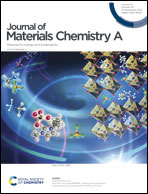A multichannel photothermal rod for antigravity water transportation and high-flux solar steam generation†
Abstract
Solar-driven interfacial evaporation is a promising technology to produce clean water from seawater or polluted water. However, the evaporation rate in existing photothermal materials is normally limited to 5 kg m−2 h−1 or below, which makes it hard to fulfil the daily water demand of a family, let alone the enormous water requirements in agricultural and industrial sectors. Herein, under the guidance of computational fluid dynamics (CFD) simulations, a multichannel photothermal rod (MCPR) is proposed as a solar interfacial material for evaporative disposal of real municipal sewage and concurrent production of freshwater. The production rate of the freshwater over a 10 centimetre-high MCPR is 18.8 kg m−2 h−1 under 1 sun, with water quality equivalent to that of commercial pure water. When the light is incident at oblique angles, faster evaporation rates are obtained (e.g., 31.3 kg m−2 h−1 at a 30° angle). Furthermore, the evaporation rate can even be raised to 126.5 kg m−2 h−1 in an outdoor environment via a magnified evaporation system constructed of a 35 centimetre-high MCPR array. These values were achievable due to a series of properties of the MCPR, including antigravity water transport, omnidirectional collection of solar energy, minimization of heat dissipation, and maximization of the evaporation interface.



 Please wait while we load your content...
Please wait while we load your content...